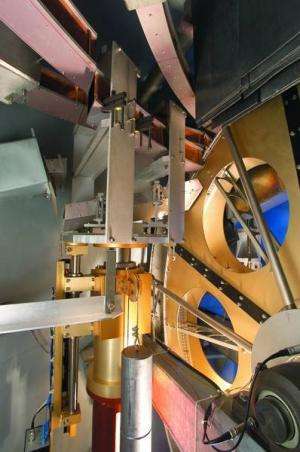Fundamental physicists discover surprise new use for super-chilled neutrons to measure the movement of viruses

Physicists working on a 60-year-old experiment to understand the origin of matter in the universe have uncovered a new tool for studying the movement of tiny particles along a surface, such as a virus travelling along a cell membrane. The new tool utilises ultra-cold neutrons (UCNs) that move slower than most people can run and will allow scientists to map the movement of tiny objects with previously unattainable precision. This discovery, made at the Institut Laue-Langevin, the world's flagship centre for neutron science and the home of ultra-cold neutron research for over 25 years, is published today in Crystallography Reports.
Since their discovery in 1969, UCNs have been used by experimental physicists to answer fundamental questions about the universe, such as the origin of matter and how gravity fits into the standard model of particle physics. They do this by collecting them in traps and monitoring properties such as their energies or lifetime at high precision.
However, the average storage time of the UCNs in their traps was always much lower than expected, affecting the quality of observations. In 1999 Dr Valery Nesvizhevsky and colleagues at the ILL discovered a new phenomenon that might explain these losses. They found that occasionally a UCN in the trap was given a small thermal 'kick'. This occurred in just 1 out of every 10,000,000 collisions, but the origin of this 'kick' was unknown.
As other hypotheses were ruled out, Dr Nesvizhevsky started to consider the influence of the nanoparticles or nanodroplets which were known to populate a layer immediately above the surface of most materials, including those of the trap's interior.
To tests this hypothesis Dr Nesvizhevsky and his colleagues returned to the UCN apparatus at the ILL. They placed samples with nanoparticle surface layers of known size distribution into the UCN trap and observed the interactions.
The team discovered that the change in UCN energy was induced by 'billiard-ball-like' collisions with moving surface nanoparticles, thus providing the first proof that these nanoparticles are not stationary.
The low energy levels of UCNs means they usually bounce off the inner walls and remain in the trap. However these shots of extra energy caused by the interaction with the nanoparticles gives them just enough energy either to overcome gravity and escape out of the top of the chamber, which is left open, or to pass right through the chamber walls.
This phenomenon has two very dramatic consequences:
1. It could explain discrepancies in the results of 60-year-old experiments measuring the lifetime of the neutron, the results of which differ by about 10 seconds, much more than the reported uncertainties would allow. A precise figure could affect conclusions on the origin of matter in the early universe, as well as on the number of families of elementary particles existing in nature, and could modify models of star formation.
2. It also gives science a brand new and uniquely accurate tool for studying for the very first time how nanoparticles move around and interact with material surfaces, particular through van der Waals/Casimir interactions, in all kinds of natural and man-made systems. Currently no other techniques exist to make these measurements.
Potential applications of this technique are vast and include the production of chemicals and semiconductors, catalytic converters, integrated circuits used in electronic devices and silver halide salts used in photographic films. The tool could also be used to study for the first time how biological molecules move along a surface such as viruses along a biological membrane.
For their next experiments, Valery and his colleagues have secured further beam time at the ILL and will be inviting scientists from various disciplines to provide samples from their own research for analysis with UCNs to prove the validity of this new technique.
More information: Crystallography Reports, September 2013, Volume 58, Issue 5, pp 743-748. link.springer.com/journal/11445/58/5/page/1
Provided by Institut Laue-Langevin

















